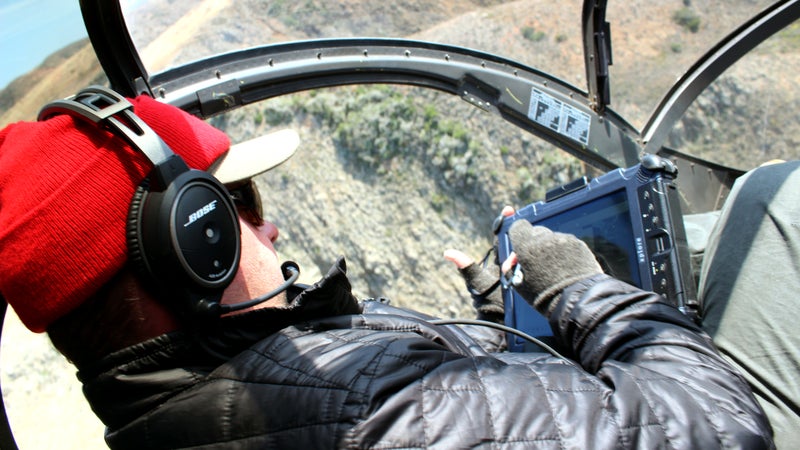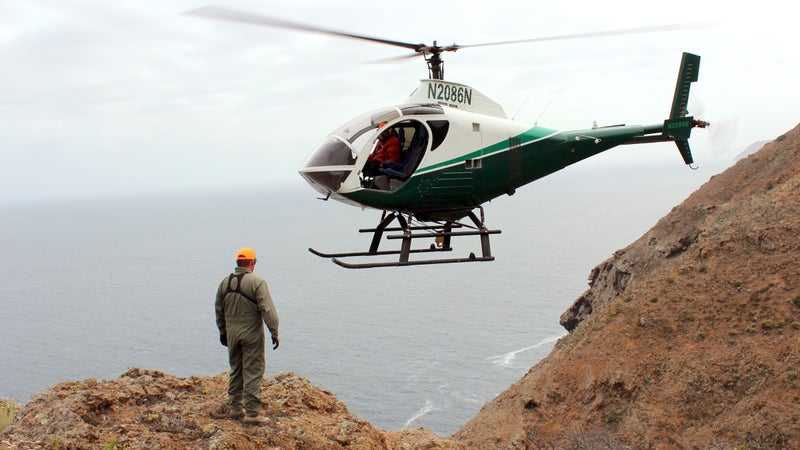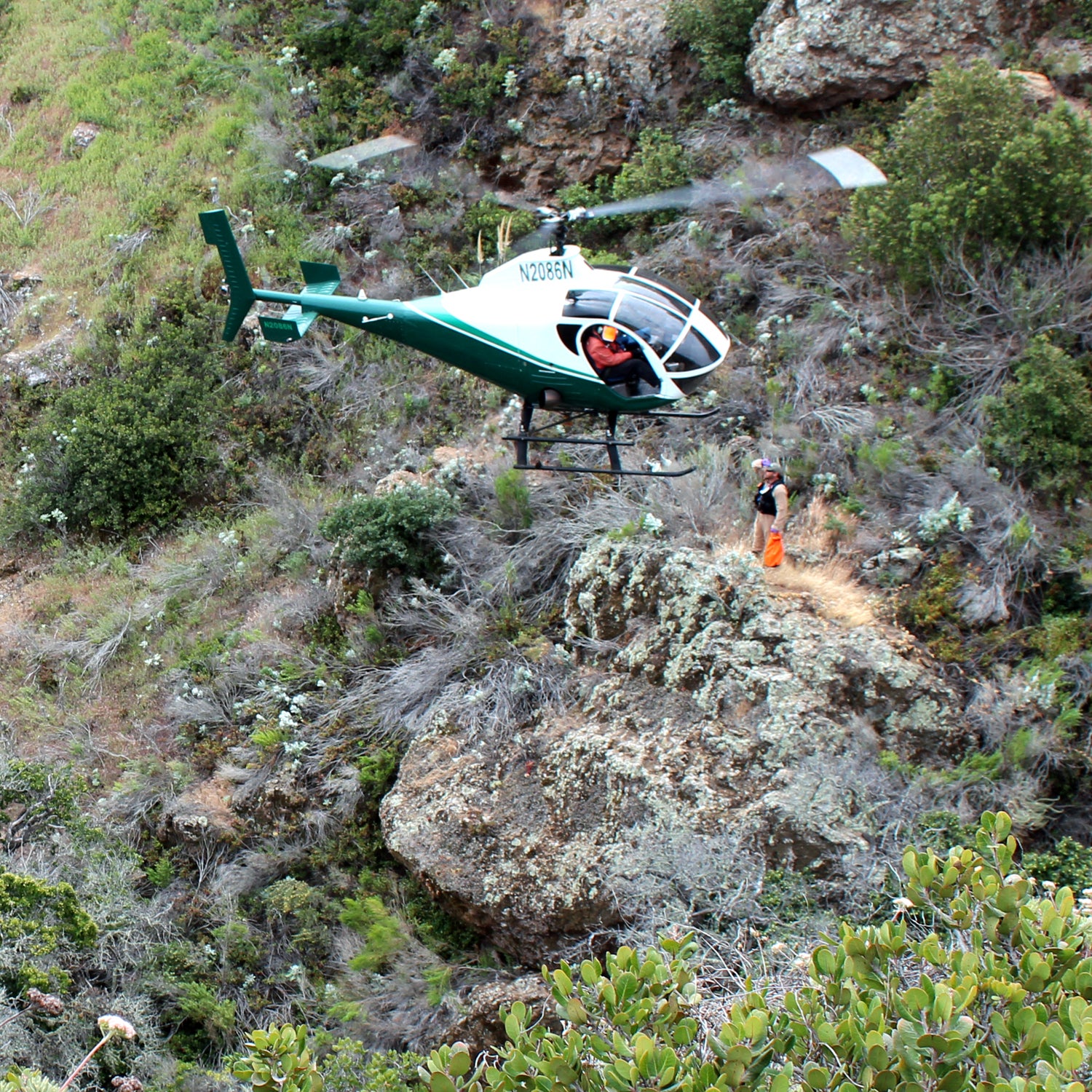“See those olive trees?” John Knapp asks me on a recent visit to Santa Cruz Island, off the coast of southern California. “They’re invasive. Wanna go in for a closer look?” I nod, and suddenly we’re falling through the sky.
Knapp is a botanist at the (TNC), the country’s largest environmental non-profit, and we are contemplating these trees not from a trail, but from 400 feet above in a three-seat Schweizer 333 helicopter with an open-air cabin. Knapp, a SoCal native in his early forties with a salt-and-paprika beard and a winning gap-toothed smile, laps up each gust of wind that blasts through the cockpit like a golden retriever leaning out of a car. Meanwhile, I inspect my surroundings for the best place to deposit the lunch I feel traveling back up my throat.
Fortunately, it’s very easy for pilot Ken Hutchins to drop me off on solid ground. (He hovers low and steady; I hop out.) In fact, that’s why TNC hired a helicopter in the first place. Santa Cruz Island, part of Channel Islands National Park and the largest island in the archipelago, is crawling with invasive species in hard-to-reach places. The Channel Islands are sometimes called “the Galapagos Islands of North America,” due to their unusually high biodiversity, and Santa Cruz Island, Knapp says, “is a hotspot within the hotspot.” But invasive species are threatening its wonderous ecology. Without intervention, the islands' more than 2,000 plant and animal species, 145 of which are found nowhere else on Earth and nine of which are endangered or threatened, could be pushed out entirely by non-native competitors like pampas grass, Spanish broom, and Peruvian pepper trees.
“I hate to use a war analogy,” John Knapp says, “but fighting invasives is kind of like Napoleon fighting wars on two fronts. Before we started using the helo, we were getting flanked.”
Invasives are a problem pretty much anywhere humans go, and constitute one of the largest threats to biodiversity in several of the country’s national parks—they’re the , for example. But on Santa Cruz Island there are both more unique native species to protect from predators and weeds, and better odds of success in managing them. In part, that’s because TNC owns and manages more than three-quarters of Santa Cruz Island. (The rest is owned by the National Park Service, which collaborates on conservation efforts.) With free rein over most of the island and a relatively large budget, TNC has been able to experiment with innovative conservation methods that smaller organizations have neither the resources nor in some cases the permission to attempt. The island is a microcosmic conservation battleground, and the helicopter represents TNC's latest and most promising weapon.
“I hate to use a war analogy,” Knapp says, “but fighting invasives is kind of like Napoleon fighting wars on two fronts. Before we started using the helo, we were getting flanked.”
Besides the invasive species that arrive at the Channel Islands naturally by air, like birds and plant seeds, more substantial invasives have been carried over by humans for the past 9,000 years, starting with the arrival of the Chumash Indians. But, as in many other places, it was European settlers who ushered in the radical ecological transformation that is causing problems today.

In the 19th century, Santa Cruz Island became a major agricultural center, with 97 square miles of grazing land for cattle, sheep, and pigs, and the largest winery in California. Ranching dropped off in the second half of the 20th century, and by 1980 several of the Channel Islands were designated a national park. TNC purchased most of Santa Cruz Island around the same time, and it’s been on a quest to supplant the island’s dozens of non-native plant and animal species ever since.
Before TNC could fully address the plant problem, though, it had to get rid of the animals. It spent the 1980s somewhat controversially exterminating more than 40,000 feral sheep, as well as live-capturing the island’s cattle and wild horses and relocating them to the mainland. In the mid-2000s, the organization made a final push to eradicate the island’s 5,000 remaining feral pigs, which were devouring every plant and small animal they could get their snouts on.
This is where the helicopter first came into play. TNC originally contracted the “helo,” as crewmembers call it, to help shuttle sharpshooters around the island in search of these pigs, the last of which was destroyed in 2006. But in a stroke of insight, the organization decided to keep the chopper around to “hunt” invasive plants. Being able to travel low to the ground, at a slow speed, allows for dropping people into rugged terrain with precision, and expedites plant surveys as well as weed killing.
It costs $750 an hour to fly in the Schweizer, which is quite a bit more than it does to send two staff members on a hike. But the helicopter gets the job done so quickly that it’s actually cost-efficient. While an invasive like fennel or saltcedar can be treated with herbicide in just five minutes, it can take hours to reach the more remote populations. By cutting out these arduous treks, the helicopter has turned a day’s worth of work into an hour’s, and a year’s worth into a month’s. “It’s twelve times faster and half the cost,” according to Lisa Park, a TNC spokeswoman.

It may also be changing the profile of the ideal botanist. Knapp observed that for the grueling hikes of TNC’s pre-helicopter days, “you wanted big, burly botanists” (perhaps the first time that phrase has been uttered) who could haul heavy herbicide tanks for miles. On the helo, in contrast, the lighter the crewmember, the better. Besides saving fuel, this can increase safety around craggy surfaces where the helo can’t land and crewmembers are required to jump on and off. In practice, this has meant a slight shift in demand from male to female staff members.
Right now, Knapp told me, a big part of the value of the helo program is showing other conservation groups and government agencies that it can be done. Enthusiasm for the experiment among federal environmental officials has been measured, but it’s growing.
No agencies have yet adopted the program, but the National Parks Service recently allowed TNC to deploy Knapp and the helicopter on nearby Santa Rosa Island (also part of the Channel Islands). Detection of invasives in national parks right now is limited to what workers on the ground see along trails and thoroughfares. If the program continues its success, it’s not a stretch to envision an airborne evolution in our approach to domestic conservation.
“It’s a real paragon of practical environmentalism,” says Doug Johnson, executive director of the California Invasive Plant Council. With a helicopter, “I could do our mapping in a week instead of fielding an army of interns for a year. I think it’s going to be an important tool in the toolbox.”


